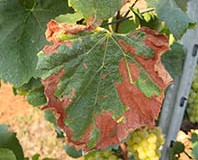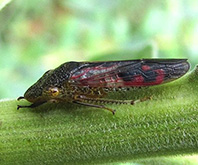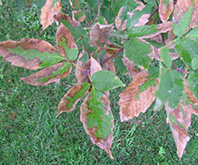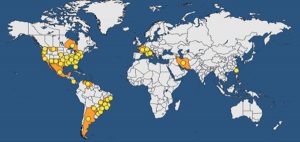Read the latest information on
Foot-and-mouth disease

Xylella on grapevine. Photo: Christine Horlock, DAF Qld
In a recent audit of around 300 exotic plant pests affecting growers overseas, the pest that came out on top with the greatest potential impact if it made it to Australia was Xylella fastidiosa (pronounced Zy-lella).
That’s partly because over 200 commercial and ornamental plants are known to be susceptible to infection by Xylella, and every year tests show it is capable of infecting more plant species.

Leaf hoppers are known to carry Xylella. This one is the glassy-winged sharpshooter, of particular concern because it feeds on a very wide range of plants. Photo: Charles Ray, Auburn University, Bugwood.org
It’s also because a wide variety of insects that feed on the fluid in the water conducting vessels (xylem) of plants are all thought to be able to spread the pathogen.
Depending on the host plant, the disease caused by Xylella is known as: Pierce’s disease, California vine disease, Anaheim disease (in grapevine), alfalfa dwarf disease (in lucerne), phony disease (in peach), leaf scald (in plum), quick decline (in olive), leaf scorch (in coffee, almond, blueberry, olive, oleander, elm, oak, plane, mulberry, maple), and variegated chlorosis (in citrus).
So if you grow any of these plants commercially, or have one in your garden, it’s worth taking the time to become familiar with the symptoms of these diseases. Generally, you will see browning or scorching of the leaves, and signs of water stress. There are a number of fact sheets available that show the symptoms on grapevines, almonds, avocados, blueberries and citrus.

Leaves of box elder (Manitoba maple, Acer negundo L.) with marginal leaf scorch caused by the bacterium Xylella. Photo: John Hartman, University of Kentucky , Bugwood.org
Routinely check your crop and all surrounding plants that can also act as a host for signs of disease. If you ever spot anything unusual on your crops (or garden plants), or see any unusual insects, please call the Exotic Plant Pest Hotline on 1800 084 881.
Infected insects are a possible route of entry into Australia. If you go on a holiday or a field trip to a country or region where Xylella is known to occur – for example a South American avocado plantation, an Italian olive grove, or in parts of North America (see map) – then take particular care when returning to Australia that you have not inadvertently carried a hitchhiking insect with you, which could have been feeding on infected plants and are carrying Xylella. Check your luggage, and clothes that you wore on the trip, especially in the field.
It’s a good idea to wash your clothes, hats, and footwear when you return from trips before going out onto your farm anyway, in case there’s some soil or spores on them that can carry other diseases.
You can also help by not buying plants or seeds from overseas websites and having them posted to Australia. There are some measures in place to prevent this now, for example via ebay, but other routes may still be possible.

This map shows where Xylella is currently known to occur. Image: European and Mediterranean Plant Protection Organization
Many of these seeds pose high biosecurity risks and require import permits and seed testing before entering Australia. For most people, the cost of meeting these conditions is much more than the price you pay. And it’s just not worth taking the risk .
Glassy-winged sharpshooter fact sheet
The European and Mediterranean Plant Protection Organization has prepared a fact sheet on Xylella which also describes the recent outbreak in Europe. It shows the devastating effects of Xylella on a variety of plants, and more images of insects that can